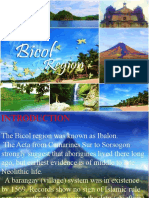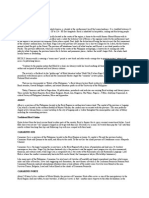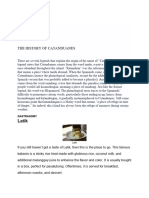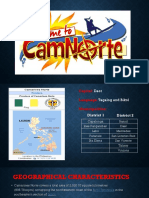0 ratings0% found this document useful (0 votes)
22 viewsMy Community
My Community
Uploaded by
michietorres7Cabcab is a barangay in San Andres, Catanduanes, Philippines with a population of 2,855 according to the 2020 census. It is made up of 544 households with an average of 5.35 members per household. Cabcab was originally settled by fishermen from Camarines who were drawn to its proximity to good fishing waters and protected shores. The name "Cabcab" originated from a man who showed Spanish conquistadors the local air plant called "beo" which he used for fanning. Fishing remains the primary economic activity, though some residents also engage in marketing, transportation, and other work. Housing structures are now primarily concrete, though some traditional huts
Copyright:
© All Rights Reserved
Available Formats
Download as PDF, TXT or read online from Scribd
My Community
My Community
Uploaded by
michietorres70 ratings0% found this document useful (0 votes)
22 views4 pagesCabcab is a barangay in San Andres, Catanduanes, Philippines with a population of 2,855 according to the 2020 census. It is made up of 544 households with an average of 5.35 members per household. Cabcab was originally settled by fishermen from Camarines who were drawn to its proximity to good fishing waters and protected shores. The name "Cabcab" originated from a man who showed Spanish conquistadors the local air plant called "beo" which he used for fanning. Fishing remains the primary economic activity, though some residents also engage in marketing, transportation, and other work. Housing structures are now primarily concrete, though some traditional huts
Original Title
my-Community
Copyright
© © All Rights Reserved
Available Formats
PDF, TXT or read online from Scribd
Share this document
Did you find this document useful?
Is this content inappropriate?
Cabcab is a barangay in San Andres, Catanduanes, Philippines with a population of 2,855 according to the 2020 census. It is made up of 544 households with an average of 5.35 members per household. Cabcab was originally settled by fishermen from Camarines who were drawn to its proximity to good fishing waters and protected shores. The name "Cabcab" originated from a man who showed Spanish conquistadors the local air plant called "beo" which he used for fanning. Fishing remains the primary economic activity, though some residents also engage in marketing, transportation, and other work. Housing structures are now primarily concrete, though some traditional huts
Copyright:
© All Rights Reserved
Available Formats
Download as PDF, TXT or read online from Scribd
Download as pdf or txt
0 ratings0% found this document useful (0 votes)
22 views4 pagesMy Community
My Community
Uploaded by
michietorres7Cabcab is a barangay in San Andres, Catanduanes, Philippines with a population of 2,855 according to the 2020 census. It is made up of 544 households with an average of 5.35 members per household. Cabcab was originally settled by fishermen from Camarines who were drawn to its proximity to good fishing waters and protected shores. The name "Cabcab" originated from a man who showed Spanish conquistadors the local air plant called "beo" which he used for fanning. Fishing remains the primary economic activity, though some residents also engage in marketing, transportation, and other work. Housing structures are now primarily concrete, though some traditional huts
Copyright:
© All Rights Reserved
Available Formats
Download as PDF, TXT or read online from Scribd
Download as pdf or txt
You are on page 1of 4
Michie I.
Torres
BSEd-Filipino 1A
My Community
Cabcab is a barangay in the municipality of San Andres, in
the province of Catanduanes. This is where I live and the
community where I belong. Based on my researched its
population as determined by the 2020 Census was 2,855.
This represented 7.42% of the total population of San
Andres.
Demographics
Households
The household population of Cabcab in the 2015 Census
was 2,912 broken down into 544 households or an average
of 5.35 members per household.
HISTORY OF BARANGAY CABCAB
Nestling at the foot of a mountain is the lovely, beautiful
and progressive community of Cabcab which has a unique
history of its own. The village the Maqueda Channel offer a
safe anchorage to fisherman and sailors braving the sea
during bad weather. These daring sea people from Ambos
Camarines often times passed the stormy days in this
unique shore. They explored the area and found it a better
place to stay. Its nearness to the mainland Camarines,
separated only by the Maqueda channel where abundant
fish abounds and the protective irregular shores together
with the fertile virgin plains encouraged the fisherman and
sailors who frequented the place to settle and start a new
life in this beautiful part of Catanduanes.
Group of fisherman settlers under the leadership of Datu
Paden decided ones and for all to stay in this place and
followed by other groups as years passed by.
One summer day, several Spanish conquiztadores crossed
the Maqueda Channel in hot pursuit of the illusive
insurrectos, made a stop over at the peaceful village. They
found the people in the village submissive and so they
enjoyed strolling around the area. In the outskirt of the
community were sturdy shady trees where the airplant
called "Beo" abounds, the Spaniards rested under these
trees. By coincidence, up in the tree was a man gathering
"Beo" Leaves for fan. The Spaniards who wanted to know
the name of the place called the man and asked "Senior
como se llama esta lugar". The man trembling with fear
without the second thought showed what he gathered to
the foreigners and said Cabccab which means that "beo" is
used for fanning.
Since then the Spaniards recorded "Cabcab" as the name
of this place. This name had been handed down unchanged
from generation to generation. Cabcab grew fast as a
fishing village. Ninety eight percent of its people are
fishermen. The main source of income of the people is b
means of fishing. Its nearness to the poblacion, six
kilometers distance connected with good road, made it
easy for them to transport their catch to market. Tanned
in the sea yet ambitious, the people in this community look
forward to give children better education. Now this
community can boast of its professionals.
Economy
Cabcab grew fast as a fishing village. Nowadays, sixty
percent of its people are fishermen. The main source of
income of the people is by means of fishing, marketing, and
even transporting vehicle(tricycle) and etc.
Structure
The structure of the houses in the baranggay are mostly
made from concrete and some are still made from kubo or
in bicol they call it "payag".
You might also like
- 438 Days: An Extraordinary True Story of Survival at SeaFrom Everand438 Days: An Extraordinary True Story of Survival at SeaRating: 4 out of 5 stars4/5 (103)
- Unit 6 Helping People Tiger TrackDocument7 pagesUnit 6 Helping People Tiger TrackBeatriz Lechón36% (11)
- F2 Region 4a To Region 5Document4 pagesF2 Region 4a To Region 5Hanz Christian RaguindinNo ratings yet
- San Narciso Zambales Area Study 2012Document49 pagesSan Narciso Zambales Area Study 2012Lauren GailNo ratings yet
- New Idaho Vaccine Exemption FormDocument2 pagesNew Idaho Vaccine Exemption FormDonnaNo ratings yet
- Biliran Provincial Mobile Force CompanyDocument4 pagesBiliran Provincial Mobile Force CompanyKriztine OlasimanNo ratings yet
- Loarca7 9Document26 pagesLoarca7 9coolcatNo ratings yet
- Cultural Variations of Catbalogan City PPT Hector Calumpiano Maed Socsci SsuDocument92 pagesCultural Variations of Catbalogan City PPT Hector Calumpiano Maed Socsci Ssucristita equibalNo ratings yet
- Bicol RegionDocument104 pagesBicol RegionRonajane Bael100% (1)
- Bicol RegionDocument104 pagesBicol RegionRonajane Bael100% (1)
- The BadjaosDocument16 pagesThe BadjaosClaire Ann LorenzoNo ratings yet
- The Province of Cavite EditedDocument34 pagesThe Province of Cavite EditedNicole RigorNo ratings yet
- MARTOS, HistoryDocument4 pagesMARTOS, HistoryJuan BakawanNo ratings yet
- Barotac Viejo HistoryDocument2 pagesBarotac Viejo Historychristineferraris8No ratings yet
- Cebuano Tagalog Municipality Province Agusan Del Norte PhilippinesDocument1 pageCebuano Tagalog Municipality Province Agusan Del Norte PhilippinesBay Nald LaraNo ratings yet
- The CordilleraDocument6 pagesThe Cordilleraapi-3047344750% (1)
- H. Region V The Bicol RegionDocument2 pagesH. Region V The Bicol RegionBambie Joy InovejasNo ratings yet
- CARAGA Region and Tuwaang Attends A WeddingDocument81 pagesCARAGA Region and Tuwaang Attends A Weddingsunshine100% (6)
- Catanduanes MasbateDocument7 pagesCatanduanes Masbateapolonioanamarie57No ratings yet
- The Bicol RegionDocument2 pagesThe Bicol RegionBambie Joy InovejasNo ratings yet
- Binalbagan and PontevedraDocument15 pagesBinalbagan and PontevedraCatherine Herilla EmeterioNo ratings yet
- Historical Legend of ManaplaDocument2 pagesHistorical Legend of ManaplaLA Yogore JermeoNo ratings yet
- 2018 Negros Occidental Travel GuideDocument64 pages2018 Negros Occidental Travel GuideSunshine GarsonNo ratings yet
- BICOLDocument9 pagesBICOLArmin NoblesNo ratings yet
- KULIATAN MARINE SANCTUARY A Case Study On The Community Based Ecotourism Project of San Joaquin, IloiloDocument9 pagesKULIATAN MARINE SANCTUARY A Case Study On The Community Based Ecotourism Project of San Joaquin, IloilohonbesoNo ratings yet
- Rosario, Cavite ResearchDocument8 pagesRosario, Cavite ResearchMarc Jim AcebarNo ratings yet
- Visayas Ethnic GroupDocument228 pagesVisayas Ethnic GroupLira PagaraNo ratings yet
- Philippine TourismDocument5 pagesPhilippine Tourismginelle95No ratings yet
- Travel Brochure - ResearchDocument5 pagesTravel Brochure - ResearchThea MitziNo ratings yet
- Bapâ Rayawan MaidanDocument11 pagesBapâ Rayawan MaidanMary Apple D. CirpoNo ratings yet
- Dinagat IslandDocument2 pagesDinagat Islandjed gumapang100% (1)
- Caribbean Coast: The Atlantic SlopeDocument27 pagesCaribbean Coast: The Atlantic SlopeMariaherva67No ratings yet
- CarcarDocument9 pagesCarcarCherry lyn EnadNo ratings yet
- Region 6Document4 pagesRegion 6tracy climacosaNo ratings yet
- Region Ii (Cagayan Valley)Document18 pagesRegion Ii (Cagayan Valley)Sherlie U BonifacioNo ratings yet
- Folkartsanddesignofsomeprovincesofluzon 131116045607 Phpapp02.ppsxDocument11 pagesFolkartsanddesignofsomeprovincesofluzon 131116045607 Phpapp02.ppsxMicaella SantiagoNo ratings yet
- I. Profile: Calaoan Ancestral DomainDocument29 pagesI. Profile: Calaoan Ancestral DomainIndomitable RakoNo ratings yet
- Camarines NorteDocument48 pagesCamarines NorteJohn Rei CabunasNo ratings yet
- Region VIDocument35 pagesRegion VIadriane aquino100% (2)
- Region Ivb MimaropaDocument3 pagesRegion Ivb MimaropaAira Lonto100% (1)
- Bicol (It Era)Document16 pagesBicol (It Era)Tsukishima RinNo ratings yet
- CAR Info 2Document3 pagesCAR Info 2Ronald GalangNo ratings yet
- ScriptDocument1 pageScriptXzyle1213No ratings yet
- Region VDocument5 pagesRegion VGarcia, Rafael Rico O.No ratings yet
- Kasaysayan NG JibatangDocument6 pagesKasaysayan NG JibatangRey RojasNo ratings yet
- The Barrios: Malapit (Tagalog Word Meaning Near) During The Spanish TimesDocument7 pagesThe Barrios: Malapit (Tagalog Word Meaning Near) During The Spanish TimesBernacris S. ReyesNo ratings yet
- The Old Man and The Sea0Literature and Its Time Vo 4 PDFDocument7 pagesThe Old Man and The Sea0Literature and Its Time Vo 4 PDFUday DesaiNo ratings yet
- BicolandiaDocument3 pagesBicolandiaLester MarquezNo ratings yet
- History of Palenque Caibiran BiliranDocument7 pagesHistory of Palenque Caibiran BiliranHarold FamorNo ratings yet
- Indigenous Group in PanamaDocument3 pagesIndigenous Group in PanamaIris Nieto100% (1)
- Chapters 1 9Document43 pagesChapters 1 9kysnonsense30No ratings yet
- Baler, AuroraDocument2 pagesBaler, AuroraFaye Vergara100% (1)
- Region IV-A&BDocument87 pagesRegion IV-A&BAnne ShareenNo ratings yet
- Brown and Beige Aesthetic Modern Group Project Presentation - 20240322 - 222656 - 0000Document29 pagesBrown and Beige Aesthetic Modern Group Project Presentation - 20240322 - 222656 - 0000ronigadian16No ratings yet
- 300 CaibiranDocument1 page300 CaibiranJen Haia Karylle HayahayNo ratings yet
- The Caribbean RegionDocument11 pagesThe Caribbean Regionmichelle RamírezNo ratings yet
- Group 1 - Prelim TPDocument74 pagesGroup 1 - Prelim TPricanel capistranoNo ratings yet
- History of Barangay 11-23Document22 pagesHistory of Barangay 11-23GirielynPoLaguismaNo ratings yet
- Valle Del CaucaDocument13 pagesValle Del CaucanicolasNo ratings yet
- Risk Mitigation and ManagementDocument47 pagesRisk Mitigation and Managementmichietorres7No ratings yet
- Michie STSDocument5 pagesMichie STSmichietorres7No ratings yet
- 3.3 THE MEDIUM OF ARTtime ArtsDocument35 pages3.3 THE MEDIUM OF ARTtime Artsmichietorres7No ratings yet
- Learning-Material-in MathDocument34 pagesLearning-Material-in Mathmichietorres7No ratings yet
- Identity Crisis Signs Symptoms TreatmentsDocument17 pagesIdentity Crisis Signs Symptoms Treatmentsmichietorres7No ratings yet
- NSTP LMC Chapter 1Document45 pagesNSTP LMC Chapter 1michietorres7No ratings yet
- Jurnal Pengenceran Semen SapiDocument10 pagesJurnal Pengenceran Semen SapiBihee'sNo ratings yet
- FCE Writing 10 - ReportDocument4 pagesFCE Writing 10 - Reportpingu70No ratings yet
- Microbiology Assignment: Microbial Diversity MollicutesDocument7 pagesMicrobiology Assignment: Microbial Diversity MollicutesVidushi GuptaNo ratings yet
- Xiikj2 NiaDocument5 pagesXiikj2 NiaAnonymous a2C6YgevfNo ratings yet
- Submarine Assurance Framework July 2021Document88 pagesSubmarine Assurance Framework July 2021cell bboyNo ratings yet
- List of Recommended Songs For The Sundays of Lent Until Good FridayDocument28 pagesList of Recommended Songs For The Sundays of Lent Until Good FridayRussel Matthew Patolot100% (1)
- Tutorial 4 Tbm1063Document2 pagesTutorial 4 Tbm1063PN BettaNo ratings yet
- 2013 Pankaj R BodadeDocument8 pages2013 Pankaj R BodadeGeorge StoicaNo ratings yet
- Lesson OneDocument6 pagesLesson OneYasmin Huang LimaNo ratings yet
- PremiumConnectionsSummarys ENGDocument12 pagesPremiumConnectionsSummarys ENGAnh Tuan NguyenNo ratings yet
- UAS PBS2 Muhammad Wildan 30201700130 PDFDocument19 pagesUAS PBS2 Muhammad Wildan 30201700130 PDFMuhammad WildanNo ratings yet
- Vector Norms: X. X Is Denoted As Kxk. X RDocument8 pagesVector Norms: X. X Is Denoted As Kxk. X Rap021No ratings yet
- Script ScenesDocument9 pagesScript Scenesapi-526691999No ratings yet
- News 2013 12Document12 pagesNews 2013 12leekiangyen100% (1)
- Influence of Iot On Smart LogisticsDocument12 pagesInfluence of Iot On Smart LogisticsGlobal Research and Development ServicesNo ratings yet
- Meaning and Nature of ConsciousnessDocument3 pagesMeaning and Nature of ConsciousnessAndrew MirandaNo ratings yet
- Soalan Halus Struktur Atom PDFDocument30 pagesSoalan Halus Struktur Atom PDFNur Irdina HaniNo ratings yet
- NotesDocument3 pagesNotes9B RAJ RISHI RANANo ratings yet
- Modle Paper 02 Part 02Document4 pagesModle Paper 02 Part 02Muhammad AmmarNo ratings yet
- BIM Ch. 4b 4.4-4.7: Inequalities: Name: SectionDocument12 pagesBIM Ch. 4b 4.4-4.7: Inequalities: Name: SectionrolloutbuddiesNo ratings yet
- The Humble BlacksmithDocument41 pagesThe Humble Blacksmithapi-347505049No ratings yet
- JKR Specification LS05 GensetDocument107 pagesJKR Specification LS05 GensetHong Leong Ku100% (5)
- Innio Fs j420 2019 A4 en Screen Ijb-119001-EnDocument2 pagesInnio Fs j420 2019 A4 en Screen Ijb-119001-EnOwais JatoiNo ratings yet
- Class Xi SciDocument3 pagesClass Xi Scimanishauttam1984No ratings yet
- To Better Maps: A TOC Primer For Strategic Planning: Recently, Many PractitionersDocument12 pagesTo Better Maps: A TOC Primer For Strategic Planning: Recently, Many PractitionersLevent KoşanNo ratings yet
- FIT CITY 1 - Promoting Physical Activity Through Design - AIA New YorkDocument32 pagesFIT CITY 1 - Promoting Physical Activity Through Design - AIA New YorkHarald Brynlund-LimaNo ratings yet
- Surgical Infections 025203Document80 pagesSurgical Infections 025203Gracie KathyNo ratings yet
- 11 LectureSlidesDocument158 pages11 LectureSlidesSpartinNo ratings yet































































































